Resources
Dive into a wealth of industry insights and expertise on the New Distributing Resources page. Your go-to destination for success in convenience retailing!
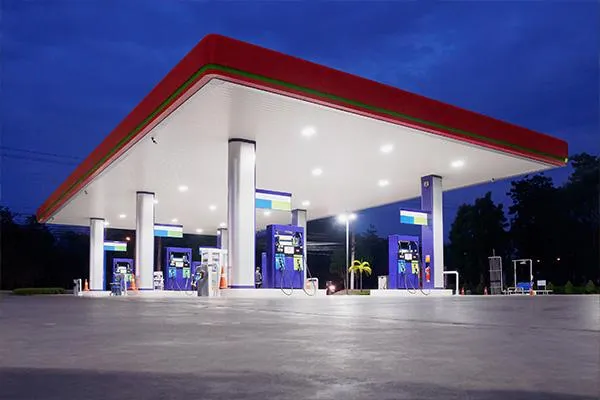
A Guide for the New Tank Owner
What is covered in this blog post:
General information about underground storage tank (UST) fueling systems in every day language.
What you need to know as a new tank owner about the Texas Commission on Environmental Quality (TCEQ) regulations.
What kind of tanks are used today?
The two most common types of tanks installed today are either Fiberglass Reinforced Plastic (FRP) or Composite (steel tank with external FRP cladding).
FRP tanks do not require any kind of corrosion protection (to keep metal from rusting) since they are made of reinforced plastic.

Showing one kind of manufactured FRP tanks installed.
Or they may look like this:

Showing a different make of FRP tank.
Composite tanks are steel tanks with an FRP coating. The one most often used composite tank today is the one with 100 mills of FRP coating and do not require corrosion protection. These are called ACT 100.

Showing an ACT 100 tank manufactured by WATCO TANKS.

There is also an ACT 100 tank that has anodes attached for extra corrosion protection for the tank.
What kinds of piping are currently used for the UST systems today?
FRP single-wall

FRP double-wall - a pipe within a pipe that should there be a leak in the inner pipe, it would be contained and a sensor would alert the tank owner of a problem before it gets into the environment).

This photo shows double-wall FRP piping.
Flexible piping- this is actually a double-wall pipe, but is flexible, meaning that it can bend, and is a little easier to install.

This shows 1 type of flexible piping, note double wall construction.
Other components of the Fuel Tank
Note: Today most all the piping systems from the fuel tank to the dispenser are pressurized, since one submerged turbine pump (STP) in the tank can supply fuel to many dispensers for cars or diesel to the big 18-wheelers.

Showing STP to supply fuel to the dispensers.
The STP
The STP also has either a mechanical line leak detector (as in the photo above) or an electronic line leak detector. Both serve the purpose of alerting the tank owner that there is a loss of pressure in the line (possibly a leak). The mechanical line leak detector slows the flow of fuel to 3 gallons per hour when the pressure drops to 10 psi. The electronic line leak detector sounds an alarm and shuts the STP down completely. Below is a photo of an electronic line leak detector.
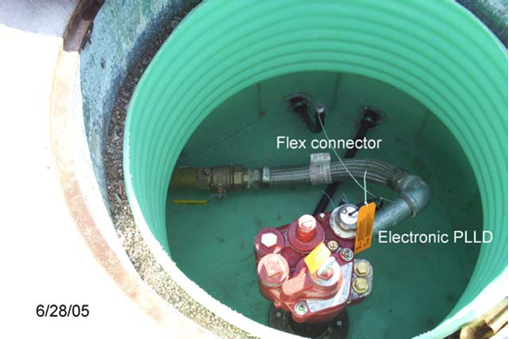
Showing an electronic line leak detector and flexible connector.
The Flexible Connector
The flexible (flex) connector is connected at both ends of the piping, at the STP and dispenser. The purpose of the flex connector is to allow for some movement of the FRP piping such as during cold weather when the ground contacts to prevent damage to the FRP piping.
Note: Flex connectors are not required when flexible piping is used. For ease of installation it is not uncommon for flex connectors to be used with flexible piping as well.
Not all STPs are located in a sump as shown above. Some older locations, during a piping upgrade, have the flex connectors installed at both ends of the piping, the flex connector is then isolated from the backfill using a boot or jacket, then it is buried in select backfill with the piping.

This shows a flex connector installed at the STP. The yellow covering is to protect the flex connector from corrosion.
Spill containment
This is sometimes referred to as a spill bucket. It is a bucket like device located at the top of each fill tube where fuel is delivered. This acts as a catchment for spills during product delivery into the underground storage tank (UST). A tight-fill fitting is also located at the top of the fill tube inside the spill containment bucket, which forms a liquid tight seal during fuel deliveries.

Showing a 5-gallon spill containment bucket on the fill tube.
Overfill prevention equipment
This is provided at the UST to prevent too much fuel from being delivered into the tank. There are basically two types.
Delivery shut-off valve located in the fill tube to physically prevent product flow into the UST when the product level reaches a preset level (95%).

Delivery shut-off valve.
Flow restrictor valve (also called a ball-float valve) is installed in the vent tube and restricts product flow into the UST when the product level reaches a preset level (90%). How it works is by closing off the vent tube, which prevents more fuel from going into the UST.

Ball float vent valve (or flow restrictor valve).
In the event that an attempt is made to overfill the tank and the delivery shut-off valve or ball float valve shuts off the flow of fuel from the delivery truck, the driver closes the valve at the tanker. Each of these devices does allow the fuel to slowly drain out of the delivery hose.
Location of components of a typical UST
Pictured below is a typical tank layout to show location major components of a typical UST.
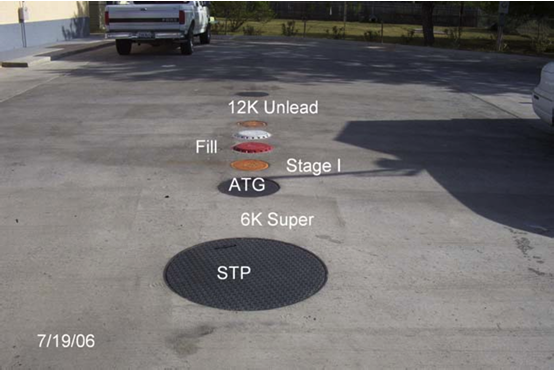
STP –Submerged turbine pump that delivers fuel to the dispensers
ATG – Automatic Tank Gauge, this probe goes into the tank to measure fuel level and water levels.
The ATG is capable of running a .2-gph tank test for release detection for the tank. This can be set up, if so equipped, to run a test with “continuous statistical leak detection” (CSLD) or programmed weekly when the store is shut down.
Stage I – This is connected to the vent line so when a delivery is made, the vapors, rather than venting to the atmosphere would be returned to the fuel delivery tanker. Stage I is required in certain counties both in the non-attainment areas (which also requires Stage II vapor recovery) and the covered attainment counties. This also contains the ball float restrictor valve set at 90% if this is the method to prevent overfills or a little higher if a delivery shut-off valve set at 95% is used.
Stage 1 Vapor Recovery Adaptors and Caps
Stage I Vapor Recovery Adaptors are installed in spill containment manholes on the vapor recovery riser pipe from an underground gasoline storage tank. They mate with the vapor recovery elbow on the delivery transport truck when recovery of gasoline vapors is required. Stage I Caps are installed on adaptors, when not in use, to prevent gasoline vapors from escaping and to prevent water, dust and debris from entering the tank.
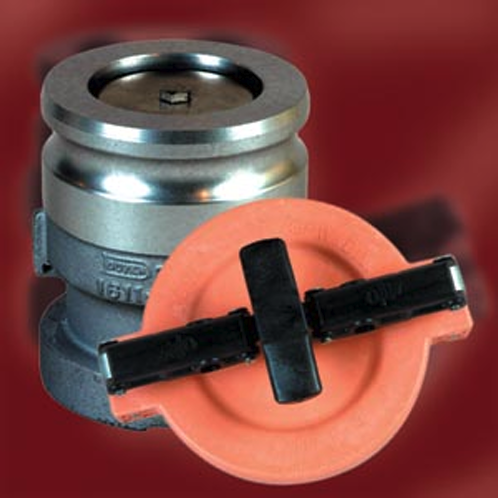
This shows the Stage I vapor recovery adaptor & cap.
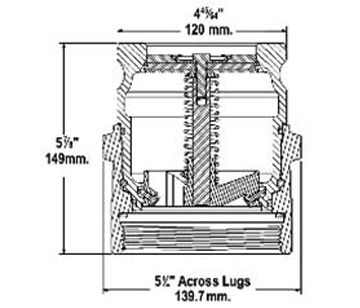
Diagram of the Stage I vapor recovery adapter.
Dispensers & Fuel Islands
Diesel fueling for big trucks
From the STP, diesel fuel is then pumped to the fuel islands for fueling 18-wheelers. The STPs for truck fueling are usually larger in size (2 hp-5 hp, sometimes with variable speed to meet demand for fuel at the dispensers) with larger nozzles for filling the large fuel tanks on the trucks.

Truck fueling area.
Fueling for autos and small trucks
A typical convenience store fuel island, shown below, has smaller hp STPs, and the dispenser nozzles are smaller than for big trucks.
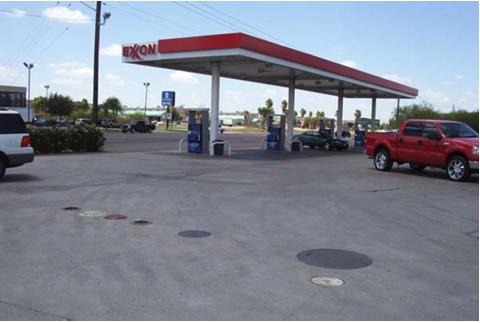
Typical auto fueling area with gas and diesel for smaller trucks.
Blending systems
Most of the modern fueling systems today at convenience stores for example, have multiple dispensers such as in the photo above. These facilities many times have unleaded, unleaded plus, super and diesel, but only have three tanks (unleaded, super & diesel). To provide unleaded plus to their customers, there is a blending system at the dispenser that that takes unleaded and super, blends them together (commonly 60% unleaded & 40% super) to meet the proper octane for unleaded plus. This blend ratio may very a little bit depending on brand of fuel (like Exxon, Shell, etc.).
Shown below are some of the major components of a fueling system. To see more information on the numbered components below, click on the web link below, and then click on “OPW system Tour:” The OPW web site is: https://www.opw-fc.com/.
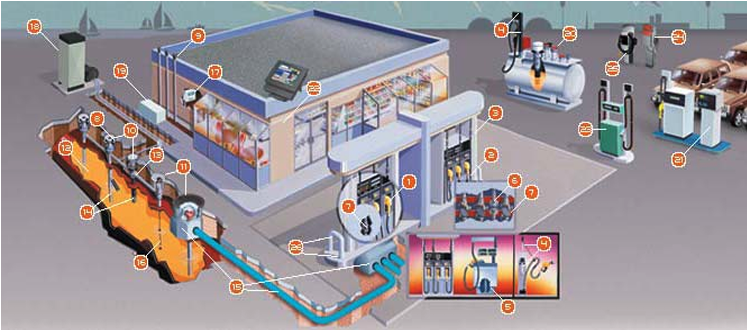
Dispensing Nozzle
Swivels
Breakaways
Hose Retractors & Hood Assemblies
Valves
Vapor Line Shear Valves
Emergency Shut-Off Valves
Caps & Adaptors
Vents
Spill Containers
Manholes
Tank Bottom Protectors
Extractor Fittings
Overfill Prevention Valves
Piping Systems
Tank Probes & Sensors
Automatic Tank Gauging & Leak Detection Systems
Vaporsaver
Aboveground Storage Tank Equipment
Automated fuel Control Systems
Retail Automation Systems
CleanEnergy Fueling Products
Eco Tire Inflation Systems
Eco Vacuum Systems
Island Forms & Pipeguards
Vapor Recovery Test Equipment
Safety & Environmental Safeguards at the Dispensers
Today, most all the UST installations have sumps at the STP, as shown previously and for the dispenser islands. The purpose for this is if there were a leak at the dispenser from the piping or a loose fuel filter, it would be contained in this sump rather than leak into the soil.

Showing sumps at the dispenser islands.
OPW Pipe Guards
Pipe guards help protect gasoline dispensers, light poles and other equipment or property from damage.
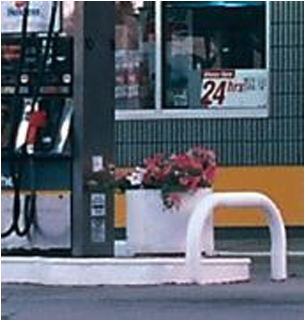
OPW 10 Series Emergency Shut-Off Valves
OPW 10 Series Emergency Shut-Off Valves are installed on fuel supply lines beneath dispensers at grade level to minimize hazards associated with collision or fire at the dispenser. If the dispenser is pulled over or dislodged by collision, the top of the valve breaks off at the integral shear groove, activating poppets and shutting off the flow of fuel. Single-Poppet models shut off supply flow, while Double-Poppet models shut off supply as well as prevent release of fuel from the dispenser’s internal piping.

Dispenser sump with emergency shut-off valve.

Showing detail of emergency shut-off valve.
Breakaways
These serve the purpose of preventing fuel from spilling on the ground, creating a fire hazard and preventing damage to the dispensers when someone drives off with the fuel nozzle still in their gas tank.

Note nozzle still in gas tank, breakaway on other end.
OPW 66REC Dry Re-connectable Breakaways
The OPW 66REC is the first dry reconnectable breakaway for the conventional dispensing market. It is designed to be installed on fuel dispensing hoses, and will separate when subjected to a designated pull force. The dual valves seat automatically, stopping the flow of fuel and limiting any fuel spillage, while protecting the dispensing equipment. When reconnecting the separated halves, the 66REC seals tightly on an O- ring before the poppet stems engage to open the valve.
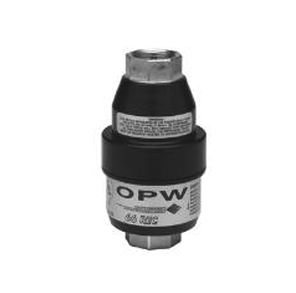
OPW 66 Breakaways
The OPW 66 is designed to be installed on fuel dispensing hoses, and will separate when subjected to a designated pull force. The dual valves seat automatically, stopping the flow of fuel and limiting any fuel spillage, while protecting the dispensing equipment.

This breakaway is a one-time use only.
OPW 66SB Swivel Breakaways
The OPW 66SB Swivel Breakaway is intended for easy installation at the nozzle inlet. The compact, lightweight design incorporates a 360° swivel rotation at both the male end and middle joint, with a simple and easily reconnectable breakaway on the opposite end.


Showing two types of breakaways at a dispenser.
Emergency Stop
As another safety precaution, an Emergency Stop is provided which shuts off fuel to all dispensers. This is used in the event of an emergency, such as a fire at the dispenser or fuel leaking out of a damaged hose or a dispenser that is hit by a vehicle. The Emergency Stop can be located in the store near the cash register, outside or both depending on local fire regulations. An Emergency Stop is required at all fueling operations, and one must be provided outside for locations that are unattended, such as the store closes at night, but allows fuel with card readers.

Emergency stop, this one located inside the store.
Originally provided by Petroleum Solutions, Inc. This blog post, "A Guide for the New Tank Owner," is meant for informational purposes only and is written in plain simple language for the new tank owner that may be useful. Petroleum Solutions, Inc. and New Distributing are in no way held responsible for the contents of this blog post.
Are You A New Distributing Partner?
Unlock the full potential of your partnership with New Distributing!
Sign up today for free access to our Partner Resources Portal, an exclusive dealer added value perk designed to empower you with a wealth of resources, templates, and expert insights.
Get In Touch With Us
Reach out to New Distributing for all your fuel and lubricant needs. Our team is ready to provide excellent service and support for our valued customers.
4102 Highway 59 North Victoria, Texas 77905
New Distributing is committed to providing exceptional products and services to our growing customer base. By partnering with us, you can meet your fueling needs with our competitively priced products delivered throughout Texas. We dedicate our time to helping our clients succeed in a highly competitive environment.
Useful Links
More
© Copyright 2025. New Distributing - Fuels & Lubricants. All rights reserved. | Privacy Policy
Professional Web Design Powered by ThriveFuel Marketing

